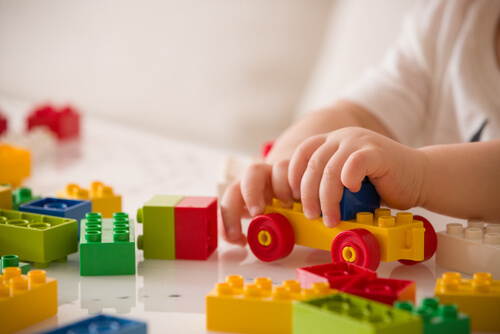
Table of contents
Early years settings adopt a wide range of techniques and methods to help promote the development of all children. From Montessori and Reggio Emilia to The Curiosity Approach and Heuristic Play, the different practices being used can be a minefield.
With its origins coming from Jean Piaget’s theory of cognitive development back in the 1920s, schema play has been around for some time now but many are still unsure of what it is and what part it plays in a child’s development.
What are schemas?
From the moment we are born, we are constantly learning new things. Schemas, which are patterns of repeated actions, helps us process and store the information we have learnt.
Once we have learnt something new, our brain stores and organises this information so that it can be called upon the next time it is needed. For example, when we see a cat for the first time as a child and learn that this is a cat, the next time we see the same animal we are able to recognise that this is indeed a cat, as our brain has stored away this information.
It is through each of these individual learnings that we are able to build on our understanding of the world, developing our cognitive structures. These cognitive structures are also referred to as schemas and they change and develop throughout the course of our lives.
How do schemas relate to early years development?
In their early development, children are building the foundations of their schemas, learning how the very basics of the world work. During this time, they will demonstrate repeated patterns or behaviours.
These repeated patterns allow children to develop their knowledge, working out what things are, how they work and how they might relate to other things they already know about.
It’s important to note that these behaviours are completely natural for children and although some actions could be seen as disruptive in their nature, schemas are a part of every child’s early years development. As well as being a huge part of how they learn about the world around them, they also promote a range of important skills.
This can include:
- Problem solving
- Critical thinking
- Fine motor skills
- Maths skills, such as measuring and estimating
How do nursery staff recognise schemas?
As part of the Early Years Foundation Stage (EYFS) curriculum, nursery staff are required to learn about the children they work with and their individual interests in order to deliver experiences and learning opportunities to suit them.
Children’s schematic interests will highlight how they are engaging with their environment at different times in their development. Recognising this and introducing schemas into play will allow nursery staff to determine different activities or experiences that work well with these natural interests, helping to build on children’s knowledge in an organic and enjoyable way.
At The Old Station Nursery Group, schema play forms one of their key foundations.
Describing the technique as “purposeful play”, a member of the Quality and Training Team at the group says:
“Each key person takes the time to really understand their key children’s interests and fascinations. If children are engaging in schematic play, our educators ensure that children have the time, space, and opportunity to engross themselves in repeating these actions, which allows children to make connections about how things work, to practice and refine their skills and to understand their environment and the world around them.
“Having knowledgeable, skilled, and attuned educators with an awareness of schemas and child development is essential in supporting young children to explore and make sense of their surroundings at The Old Station Nursery Group.”
What are the different types of schemas and how are they incorporated into play?
There are nine different types of schema that are commonly recognised.
Children may engage with some, all, or even none of these schemas during their early years development.
Below, we explain the different types of schemas and how they can be incorporated into play.
1. Connecting
The connecting schema involves working out how objects are able to go together.
Children engaging with this schema may enjoy:
- Playing with building blocks, such as Lego
- Piecing together a train track or puzzles
- Using a shape sorting hammer bench
Children could also be interested in disconnecting things, such as knocking things down once they have been built.
2. Enclosing
Within this schema, children will be interested in creating a barrier around an object or themselves. It is also sometime referred to as containing.
This could be incorporated into play by:
- Drawing circles around a picture they have drawn
- Playing with cardboard boxes or lunch boxes
- Placing items around a toy they are playing with to create a border
- Using bubble wrap in an arts & crafts session
Children might also want to enclose themselves, for example, by fitting themselves into small places, such as a box or a den or building a fort.
3. Enveloping
Enveloping can be seen as an extension of enclosing. Children engaging with this schema will enjoy covering themselves or other objects.
This could include:
- Putting a blanket over themselves and playing peek-a-boo
- Hiding objects in cupboards or drawers
- Climbing into things
4. Orientation
This is where children learn more about their viewpoint of the world. They will be interested in how things look from different positions or angles.
For example, they may:
- Turn objects around to see them at different points
- Put themselves into different positions, such as looking backwards through their legs or hanging upside down
- Look through mirrors, binoculars or a magnifying glass
Taking safe risks will be a key part of the orientation schema. Children should be supervised to do things like climb or hang using suitable resources.
5. Positioning
Just as it sounds, the positioning schema involves children placing items in a particular order or place.
For example, a child may:
- Line up or sort their toys by categories such as height or colour
- Play with stacking blocks or build a tower
Positioning can often be linked with OCD-type behaviours, but for the majority of children, this is a completely normal part of development that helps them to develop a range of important skills.
If you are concerned about any of your child’s behaviours, it’s a good idea to get in touch with your GP. They will be able to give you a professional opinion and help to alleviate any concerns.
6. Rotational or circular
Many children are interested in how things can be moved. Rotational, or sometimes referred to as circular, schema relates specifically to moving things in a circular motion.
For example, children might twist or spin items. This could involve:
- Twirling around themselves
- Twisting a tap on and off
- Playing with a windmill
- Using relevant outside equipment, such as a roundabout
7. Trajectory
An extension of the rotational schema, trajection refers to children’s interest in how things move vertically, horizontally and diagonally.
This can be disruptive without guidance as children may throw, drop or swing items.
To encourage safe play, children could:
- Throw leaves up into the air
- Roll or throw a soft ball
- Play on a swing or a hammock
As with orientation, giving children the opportunity to take safe risks will be key to them being able to explore this schema.
8. Transforming
The transforming schema, as it sounds, is where children learn about how things change. This could be in texture, shape or size or colour, for example.
Activities could include:
- Playing with sand and water, looking at the transformations in texture, substance or appearance
- Mixing paints together and seeing the colours change
9. Transporting
Similar to the rotational schema, transporting demonstrates an interest in how things move. Children engaging with this schema will usually enjoy carrying objects from one place to another.
The transporting schema is common in many children, and allows them to learn where things go and how distances work.
Children might be encouraged to:
- Push a pram or wheelbarrow with their toys inside
- Use pots or containers to carry things around
- Tidy up their environment, moving things back to where they should be


